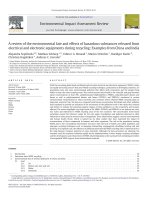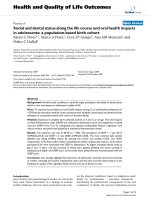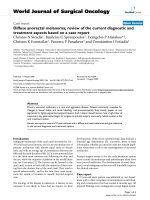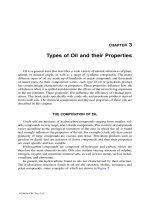Lecture Massage therapy review: Passing the NCETMB, NCETM, and MBLEx (2/e): Chapter 3 - Laura A. Abbott
Bạn đang xem bản rút gọn của tài liệu. Xem và tải ngay bản đầy đủ của tài liệu tại đây (1.38 MB, 20 trang )
Massage Therapy Review:
Passing the NCETMB, NCETM, and MBLEx
Chapter 3
Pathology
McGrawHill
© 2011 by The McGrawHill Companies, Inc. All rights reserved
3-2
Preclass Assignment
Review Chapter 3 of
your Massage
Therapy Review
book
McGrawHill
© 2011 by The McGrawHill Companies, Inc. All rights reserved
3-3
Terminology
Pathology
Acute
Chronic
Disease
Pathophysiology
– Endemic
– Epidemic
– Pandemic
Etiology
Morbidity
Mortality
McGrawHill
© 2011 by The McGrawHill Companies, Inc. All rights reserved
3-4
Understanding Medical Terminology
Terminology helps us to understand and break
down words, some of which may be
unfamiliar to us.
Be familiar with the At a Glance: Medical
Terminology chart in the Massage Therapy
Review Book.
McGrawHill
© 2011 by The McGrawHill Companies, Inc. All rights reserved
3-5
Nine Regions of the Abdomen
Right
Hypochondriac
Region
Epigastric
Region
Right
Lumbar
Region
Right
Iliac
Region
Umbilical Region
McGrawHill
Hypogastric
Region
Left
Hypochondriac
Region
Left
Lumbar
Region
Left
Iliac
Region
© 2011 by The McGrawHill Companies, Inc. All rights reserved
3-6
Risk Factors for Disease
Age
Gender
Genetics
Physical Exposure
Nutrition
Congenital Defects
Occupational Hazards
Preexisting Conditions
Lifestyle and Habits
McGrawHill
© 2011 by The McGrawHill Companies, Inc. All rights reserved
3-7
Microorganisms
Bacteria
Fungi
Protozoans
Viruses
McGrawHill
© 2011 by The McGrawHill Companies, Inc. All rights reserved
3-8
Modes of Transmission
Mucous Membranes
Intact Skin
Broken Skin
Ingestion
Inhalation
McGrawHill
© 2011 by The McGrawHill Companies, Inc. All rights reserved
3-9
Signs of Inflammation
Redness
Swelling
Reduction of
blood flow
Buildup of
metabolic waste
Tense, spasmed or
contracted
muscles
Pain
Heat
Pain
McGrawHill
© 2011 by The McGrawHill Companies, Inc. All rights reserved
3-10
Disorders and Diseases
Medical Clearances
Indicated
Indicated with Restrictions
Absolute Contraindications
McGrawHill
© 2011 by The McGrawHill Companies, Inc. All rights reserved
3-11
Indicated with Restrictions
Acne
Boils
Bunions
Burns
Fibromyalgia
Gout (nonacute)
Hematoma
Hernia
Impetigo
Multiple Sclerosis
Osteoarthritis
Osteoporosis
Psoriasis
Rheumatoid Arthritis
Tendonitis
Varicose Veins
Herniated Disc
McGrawHill
© 2011 by The McGrawHill Companies, Inc. All rights reserved
3-12
Absolute Contraindications
Alcoholism or
Drunkenness
Amyotrophic Lateral
Sclerosis (Lou Gehrig’s)
Bronchitis
Cancers
Congestive Heart Failure
COPD/Emphysema
Diabetes
Edema
McGrawHill
Fever
Gout (acute)
Hepatitis
HIV/AIDS
Impetigo
MI/Angina
Osteomalacia
Seizures
Shingles
Substance Abuse
© 2011 by The McGrawHill Companies, Inc. All rights reserved
3-13
Signs and Symptoms
Review and understand
the signs, symptoms,
and massage
implications
At a Glance: Signs and
Symptoms of Disease
chart in the Massage
Therapy Review Book.
McGrawHill
© 2011 by The McGrawHill Companies, Inc. All rights reserved
3-14
Stages of Cancer
Stage One
– Small lump that has invaded tissue beyond
lobules or ducts but not yet spread to nodes or
other areas.
Stage Two
– Slightly larger tumor size, or enlarged lymph
nodes that indicate more trouble may be
imminent. No sign of metastases.
McGrawHill
© 2011 by The McGrawHill Companies, Inc. All rights reserved
3-15
Stages of Cancer, Cont’d
Stage Three
– Tumor is larger than 2 inches or has invaded other
areas. Lymph nodes are enlarged. No concrete
cancer in other organs.
Stage Four
– Cancer is detectable in other organs.
McGrawHill
© 2011 by The McGrawHill Companies, Inc. All rights reserved
3-16
Drugs and Their Effects
Be familiar with charts on pages 114–116
Common medications:
–
–
–
–
–
Blood Pressure
Cardiovascular
Diabetes
Hormone Replacements
Thyroid
Note: If clients are taking antibiotics and are contagious, you
shouldn’t be massaging them!
McGrawHill
© 2011 by The McGrawHill Companies, Inc. All rights reserved
3-17
Physical and Emotional Abuse
Stress and Its Effects
Traumatic Distress
– How quickly the client is upset
– How frequently it is triggered
– How intense the source is
– How long the upset lasts
– How long it takes to calm down
McGrawHill
© 2011 by The McGrawHill Companies, Inc. All rights reserved
3-18
Physical Symptoms of Trauma
Eating Disturbances
Sleep Disturbances
Sexual Dysfunction
Low Energy
Chronic or
Unexplained Pain
McGrawHill
© 2011 by The McGrawHill Companies, Inc. All rights reserved
3-19
Emotional Symptoms of Trauma
Depression
Spontaneous Crying
Anxiety
Panic Attacks
Fearfulness
Compulsive/Obsessive Behaviors
Irritability, Anger
McGrawHill
© 2011 by The McGrawHill Companies, Inc. All rights reserved
3-20
Cognitive Symptoms of Trauma
Memory Lapses
Difficulty Making Decisions
Decreased Ability to Concentrate
Feeling of Distracted
McGrawHill
© 2011 by The McGrawHill Companies, Inc. All rights reserved









